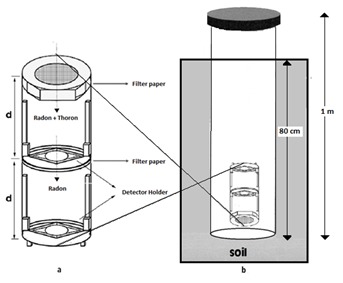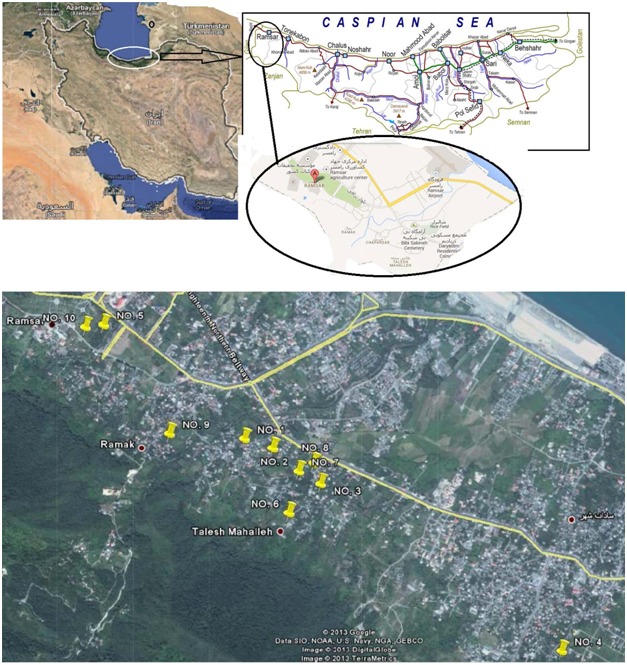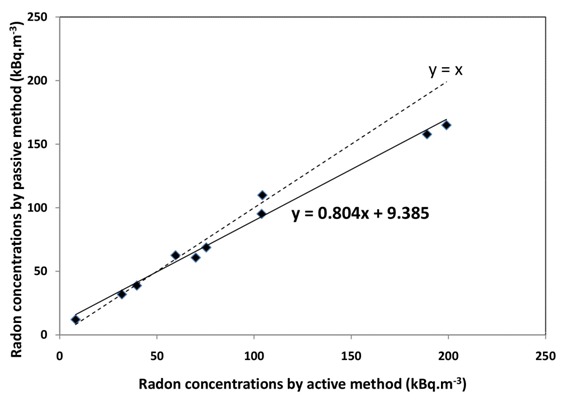Abstract
Background: Radon and its daughters are amongst the most important sources of natural exposure in the world. Soil is one of the significant sources of radon/thoron due to both radium and thorium so that the emanated thoron from it may cause increased uncertainties in radon measurements. Recently, a diffusion chamber has been designed and optimized for passive discriminative measurements of radon/thoron concentrations in soil.
Objective: In order to evaluate the capability of the passive method, some comparative measurements (with active methods) have been performed.
Method: The method is based upon measurements by a diffusion chamber, including two Lexan polycarbonate SSNTDs, which can discriminate the emanated radon/thorn from the soil by delay method. The comparative measurements have been done in ten selected points of HLNRA of Ramsar in Iran. The linear regression and correlation between the results of two methods have been studied.
Results: The results show that the radon concentrations are within the range of 12.1 to 165 kBq/m3 values. The correlation between the results of active and passive methods was measured by 0.99 value. As well, the thoron concentrations have been measured between 1.9 to 29.5 kBq/m3 values at the points.
Conclusion: The sensitivity as well as the strong correlation with active measurements shows that the new low-cost passive method is appropriate for accurate seasonal measurements of radon and thoron concentration in soil.
Keywords: Radon, Ramsar, Passive Detectors, SSNTD
Introduction
Radon and its daughters are amonst the most important sources of natural exposure in the world. Based on the epidemiological studies, inhalation of radon can cause lung cancer particularly in its high-level concentrations, also known as the second leading cause of the cancer [1, 2]. This noble radioactive gas is the daughter of natural radium which is released into the environments through surface waters, soil and rocks and naturally found in groundwater. Among the sources, soil has its particular importance due to both radium and thorium which is the thoron parent. In spite of short half-life of the thoron (less than 1 minute) in comparison with that of radon (3.8 days), the emanated thoron from the soil may cause increased uncertainties in radon measurements [3].
Although the radon may be found in any regions, some areas such as Kerala in India, cities like Yangjiang in China, Ramsar in Iran, as well as the Flinders Ranges in Australia and the town of Guarapari in Brazil are known as HNLRA due to high level of radon concentrations. Thus the accurate measurements of radon concentration in the soil of the areas are the subject of investigations [4].
Recently, a diffusion chamber has been designed and optimized for passive discriminative measurements of radon/thoron concentrations in the soil [5]. The method is based upon the measurement by a diffusion chamber, including two Lexan polycarbonate SSNTDs, which can discriminate the emanated radon/thorn from the soil by delay method.
In this research, some comparative measurements (with active methods) have been performed in HLNRA of Ramsar in Iran in order to evaluate the capability of the passive method. As well, the linear regression and correlation between the results of two methods have been studied.
Material And Methods
The configuration of passive chamber is shown in figure 1.a. In the chamber, the volume is divided by two parts which consist of two fiber glass filters as well as two polycarbonates Lexan nuclear track detectors (film). Both radon and thoron can diffuse the chamber and be detected by upper film. The distribution of 220 Rn within the cylindrical diffusion chamber decreases exponentially with the distance from the entry filter. As well, only the radon can diffuse through the holes/second fiber glass filter inside of the lower volume and be detected by lower film. Thus the upper film detects both radon and thoron and the lower film can only detect the radon. The sensitivity of the detectors have been measured by 16.85 and 17.25 track.cm -2 (kBq.m -3 day) -1 values for radon in the lower and upper Lexan films respectively, and by 1.76 [track.cm -2 (kBq.m -3 day) -1 ] value for thoron in the upper film [5].
Figure 1.

(a) Configuration of diffusion chamber used for discriminative measurements of radon/thoron.
(b) Method of measurement by means of the chamber inside of deep small well.
Electrochemical etching (ECE) process was applied to magnify the latent tracks on the films. The etchant solution, PEW, consists of 15%KOH, 40% C2H5OH and 45% H2O by weight was applied at 250C followed by a 32 kV/cm electrical field strength, 2 kHz frequency and duration of 3 h [6].
The radon and thoron concentrations are calculated by [7]:
Where CRn is the concentration of radon in soil (kBq/m 3 ), TL is the track density of the lower film (track/cm 2 ), D is exposure time (days) and KRn is the related sensitivity (L for lower film and U for upper film).
For the measurements, the chamber has been placed in small wells with depth of 1 m, as shown in figure 1.b in reversed direction for a duration time of two days. As well, an Alpha-guard active measurement system was applied for comparison with the results of the passive measurements. For this aim, the probe was placed inside of the small wells at 80 cm depth (figure 2).
Figure 2.

Alpha Guard system (Active method)
The measurements have been performed at 10 different selected points in HLNRA of Ramsar using both active and passive methods simultaneously. The points have been selected based upon high concentration measurements of radon in the air at 1 m altitude, and are shown in figure 3.
Figure 3.

The locations of measured points in Ramsar.
Results and Discussions
The results of both measurements along with the corresponding geographical coordinates of the points have been presented in table 1. The concentrations of radon in the soil have been measured within the range of 12.1 to 165 kBq/m 3 values by passive method which is comparable with that of 8.2 to 189.0 kBq/m 3 values for active method.
Table 1.
Concentration of radon / thoron which are measured using active and passive method in the soil of Ramsar
| Cell No | Longitude | Latitude |
Concentration radon
(active method) (kBq/m 3 ) |
Concentration radon
(passive method) (kBq/m 3 ) |
Concentration Thoron
(passive method) (kBq/m 3 ) |
Temperate
(oC) |
Moisture
(%) |
|---|---|---|---|---|---|---|---|
| 1 | 36O 53’ 44.1” | 50O 40’ 21” | 32.0 | 31.9 | 8.6 | 26 | 72 |
| 2 | 36O 53’ 42” | 50O 40’ 29” | 39.7 | 38.8 | 18.6 | 30 | 75 |
| 3 | 36O 53’ 34.1” | 50O 40’ 42.1” | 59.6 | 62.6 | 14.7 | 27 | 74 |
| 4 | 36O 52’ 57.2” | 50O 41’ 47.6” | 8.2 | 12.1 | 1.9 | 28 | 76 |
| 5 | 36O 54’ 09.0” | 50O 39’43” | 199.0 | 165.0 | 16.5 | 30 | 77 |
| 6 | 36O 53’ 27.9” | 50O 40’ 33.3” | 104.3 | 109.9 | 29.5 | 27 | 75 |
| 7 | 36O 53’ 37” | 50O 40’ 36” | 75.4 | 68.8 | 21.4 | 27 | 74 |
| 8 | 36O 53’ 38.7” | 50O 40’ 40.1” | 189.0 | 157.8 | 5.0 | 26 | 67 |
| 9 | 36O 53’ 45.2” | 50O 40’ 01” | 103.9 | 95.2 | 28.6 | 25 | 69 |
| 10 | 36O 54’ 08.5” | 50O 40’ 38.1” | 70.0 | 60.8 | 15.3 | 27 | 79 |
In figure 4, the linear regression curve has been shown as solid line for passive versus active method. Considering the x=y line (dashed line), the results show that the measured values obtained by passive method are inconsistent with that of active method in low concentrations, whereas they are under-estimated in that of higher concentrations. The reason for the under-estimation is that the registered tracks on the film may be overlapped in exposures with higher radon concentrations. However the correlation value between the results of active and passive methods was measured by 0.99. The value demonstrates an appropriate correlation between the passive and active measurements.
Figure 4.

The linear regression curve for two passive and active methods (solid line) and comparison with y=x dashed line.
Also the thoron concentrations have been measured to be between 1.9 to 29.5 kBq/m 3 values at the points. The results show the importance of thoron discrimination from the measurements.
Conclusion
A home-made passive diffusion chamber which is based on lexan SSNTD has been developed for separated measurements of radon/ thoron in soil. The sensitivity as well as the strong correlation with active measurements shows that it is appropriate for accurate seasonal measurements of radon and thoron concentration in soil. The advantages of the method are inclusive of its low-cost, small size chamber, light weight, simple etching process and its capability of being used in an extended range of radon/thoron concentrations, which make it useful for large scale measurements.
Conflict of Interest: None
References
- 1.Lubin JH, Boice JD Jr . Lung cancer risk from residential radon: meta-analysis of eight epidemiologic studies. J Natl Cancer Inst. 1997;89:49–57. doi: 10.1093/jnci/89.1.49. Epub 1997/01/01. PubMed PMID: 8978406. [DOI] [PubMed] [Google Scholar]
- 2.Barros-Dios JM, Ruano-Ravina A, Perez-Rios M, Castro-Bernardez M, Abal-Arca J, Tojo-Castro M. Residential radon exposure, histologic types, and lung cancer risk. A case-control study in Galicia, Spain. Cancer epidemiol biomarkers prev. 2012;21:951–8. doi: 10.1158/1055-9965.EPI-12-0146-T. Epub 2012/04/28. doi: 10.1158/1055-9965.epi-12-0146-t. PubMed PMID: 22539606. [DOI] [PubMed] [Google Scholar]
- 3.Chen J, Rahman NM, Abu Atiya. Radon exhalation from building materials for decorative use. J Environ Radioactivity. 2010;101:317–22. doi: 10.1016/j.jenvrad.2010.01.005. Epub 2010/02/20. doi: 10.1016/j.jenvrad.2010.01.005. PubMed PMID: 20167403. [DOI] [PubMed] [Google Scholar]
- 4.Ghiassi-nejad M, Mortazavi SM, Cameron JR, Niroomand-rad A, Karam PA. Very high background radiation areas of Ramsar, Iran: preliminary biological studies. Health phys. 2002;82:87–93. doi: 10.1097/00004032-200201000-00011. Epub 2002/01/05. PubMed PMID: 11769138. [DOI] [PubMed] [Google Scholar]
- 5.Amanat B, Kardan MR, Faghihi R, Taheri M. Calibration and optimization of a low cost diffusion chamber for passive separated measurements of radon and thoron in soil by Lexan PC SSNTD. Int J Radiat Res. 2014;12(1):61–67. [Google Scholar]
- 6.Taheri M, HosseiniToudeshki S. Characteristic studies for fast detection of a wide energy range of alpha particles in polycarbonate detectors. Radiation Measurements. 2005;40(2):307–310. doi: 10.1016/j.radmeas.2005.06.019. [Google Scholar]
- 7.Guo Q, Iida T, Okamoto K, Yamasaki T. Measurements of thoron concentration by passive cup method and its application to dose assessment. J Nuclear Sci Technol. 1995;32(2):794–803. doi: 10.1080/18811248.1995.9731775. [Google Scholar]


